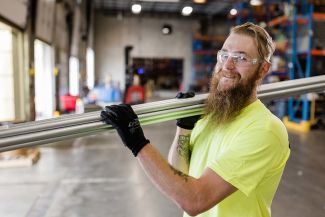2023's Trending Topics in Electrical Prefab
- April 25, 2023
- Best Practices
- Electrical

What if instead of running wire through conduit on a jobsite, you could get metal tubing prepackaged with wire inside? How much time could you save on installation? Most people probably don’t think of MC cable as “prefabbed” material, but it’s a good example of how packaging solutions ahead of time can save contractors time and labor during installation. MC cable is old news though. To help you save time and win more jobs, keep up with these newer trends in construction and electrical prefab.
1. A RISE IN PREFAB SHOPS & A CHANGING MENTALITY
Setting up a prefab shop does take a significant investment, but it’s not just a luxury for large contractors anymore. Most tasks on a jobsite can be prefabricated, and if you can afford the investment, you should be prefabbing regardless of the size of your operation. Prefab can save contractors time, labor and material cost, so what is stopping more electrical contractors from using prefab? Part of it is changing mentality in the industry.
The “old school” mentality is that prefab isn’t needed and takes away from jobs in the field. The reality is that the contractors saving money with prefab are winning more jobs, and able to keep their team busy. People are starting to recognize the value of prefab, and the market for it is growing. The global modular and prefabricated construction market exceeded $147 billion in 2022 and is expected to grow by 6.5% annually to reach $285 billion by 2032.
2. CENTRALIZATION OF WORK
The U.S. Bureau of Labor Statistics projects 50,000 more electrician jobs will be needed by 2031. With a workforce shortage, how can you get the most production out of your current workforce?
You probably have a strong team of highly educated electricians, but if you are entering a new market, what is the labor force like there? Will you get the same quality work? Centralizing work to one location allows contractors to operate in a location they are already familiar with and a workforce they can trust.
3. SMARTER INVENTORY MANAGEMENT
One of the advantages of prefab is that it reduces material cost, and it is easier to manage the parts you need on-hand. For example, if you have 50 electricians on different job sites and they all need connectors, you would have to order 50 boxes of connectors. You might end up with 25 boxes worth of extra connectors you don’t need. If those 50 electricians are working in a centralized prefab shop instead, they can all use connectors from the same supply, and it is easier to plan for the total number of connectors they actually need.
There are even solutions to make inventory management smarter and more efficient. Contractors are beginning to look into hardware and software solutions, like Storeroom Logix , to store products in a vending machine, locker or storeroom, and track when items are used via radio-frequency identification (RFID). If something goes missing, they can see who checked it out and when. With Storeroom Logix, the software portion tracks inventory levels and can automatically reorder parts according to usage and supplier inventory-based minimum and maximum levels.
In addition, the movement toward effectively managing inventory also improves safety. Prefab creates a cleaner, safer jobsite by reducing the number of spare parts and people required to complete a job. With a prefab solution, it gets shipped to the site, the electrician puts it where it’s supposed to go, and it’s done. Fewer people and less time on a jobsite means less risk for injury.
4. CUSTOM-DESIGNED SOLUTIONS
The most successful prefab shops have a design team that can customize solutions to meet their customers’ needs before they even arrive on the jobsite. Use a hotel for example. If you have the layout of each room, you could wire out whole rooms with MC cable, cut it to length and mark it, so once it gets to the room, it’s ready to pull into the studs of the walls. Room 101 might be different than 102 and so on, but designing a custom solution for each room ahead of time saves time and reduces labor cost by simplifying the installation process
It doesn’t have to be wire. Pipe and wireways, gear assemblies and more can be customized to meet specific customer requirements. The only limit on customization is the ability to think outside the box and discover new ways to save time.
5. TIMESAVING TECHNOLOGIES
Crafting solutions at one centralized prefab shop allows contractors to better utilize technology and automate processes. Centralizing your operations under one roof allows you to operate more like an industrial manufacturer with automated production lines which can produce more in less time.
Other technologies like 3D modeling, virtual reality and augmented reality can give contractors insight into the jobsites they will be working on before they arrive on site. With a VR headset or AR glasses, workers can view the jobsite and make more informed plans regarding the installation process. 3D modeling allows planners to digitally view the project from every angle and design customer-specific solutions before workers and materials arrive on the jobsite.
Are there other trends you are curious about? Reach out to your account manager to find out how Van Meter can help you find opportunities to be more efficient. From delivery to product staging to inventory management, we can provide Everything You Need to Succeed.

ARTICLE BY:
CHRIS SICARD
EMPLOYEE-OWNER, ACCOUNT MANAGER